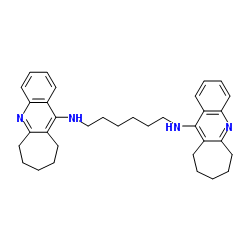GSK-3 BETA

GSK-3 BETA structure
|
Common Name | GSK-3 BETA | ||
|---|---|---|---|---|
| CAS Number | 9059-09-0 | Molecular Weight | 506.724 | |
| Density | 1.2±0.1 g/cm3 | Boiling Point | 746.6±60.0 °C at 760 mmHg | |
| Molecular Formula | C34H42N4 | Melting Point | N/A | |
| MSDS | USA | Flash Point | 405.3±32.9 °C | |
|
Selectivity and anti-Parkinson's potential of thiadiazolidinone RGS4 inhibitors.
ACS Chem. Neurosci. 6 , 911-9, (2015) Many current therapies target G protein coupled receptors (GPCR), transporters, or ion channels. In addition to directly targeting these proteins, disrupting the protein-protein interactions that localize or regulate their function could enhance selectivity a... |
|
|
Requirement for glycogen synthase kinase-3beta in cell survival and NF-kappaB activation.
Nature 406(6791) , 86-90, (2000) Glycogen synthase kinase-3 (GSK-3)-alpha and -beta are closely related protein-serine kinases, which act as inhibitory components of Wnt signalling during embryonic development and cell proliferation in adult tissues. Insight into the physiological function o... |
|
|
Glycogen synthase kinase-3beta regulates cyclin D1 proteolysis and subcellular localization.
Genes Dev. 12(22) , 3499-511, (1998) The activities of cyclin D-dependent kinases serve to integrate extracellular signaling during G1 phase with the cell-cycle engine that regulates DNA replication and mitosis. Induction of D-type cyclins and their assembly into holoenzyme complexes depend on m... |
|
|
Progesterone receptor A stability is mediated by glycogen synthase kinase-3β in the Brca1-deficient mammary gland.
J. Biol. Chem. 288(36) , 26265-74, (2013) Germ line mutations of the BRCA1 gene increase the risk of breast and ovarian cancer, but the basis of this tissue-specific tumor predisposition is not fully understood. Previously, we reported that the progesterone receptors are stabilized in Brca1-deficient... |
|
|
N-terminal cleavage of GSK-3 by calpain: a new form of GSK-3 regulation.
J. Biol. Chem. 282(31) , 22406-13, (2007) Although GSK-3 activity can be regulated by phosphorylation and through interaction with GSK-3-binding proteins, here we describe N-terminal proteolysis as a novel way to regulate GSK-3. When brain extracts were exposed to calcium, GSK-3 was truncated, genera... |
|
|
Processing of the gastrin precursor. Modulation of phosphorylated, sulfated, and amidated products.
J. Biol. Chem. 265(35) , 21476-81, (1990) Post-translational processing of the precursor for rat gastrin yields products that include peptides phosphorylated at Ser96, amidated at Phe92, and sulfated at Tyr87 or Tyr103. The phosphorylation site is immediately adjacent to the processing point that giv... |
|
|
The glamour and gloom of glycogen synthase kinase-3.
Trends Biochem. Sci. 29(2) , 95-102, (2004) Glycogen synthase kinase-3 (GSK3) is now recognized as a key component of a surprisingly large number of cellular processes and diseases. Several mechanisms play a part in controlling the actions of GSK3, including phosphorylation, protein complex formation, ... |
|
|
The multifaceted roles of glycogen synthase kinase 3beta in cellular signaling.
Prog. Neurobiol. 65(4) , 391-426, (2001) Glycogen synthase kinase-3beta (GSK3beta) is a fascinating enzyme with an astoundingly diverse number of actions in intracellular signaling systems. GSK3beta activity is regulated by serine (inhibitory) and tyrosine (stimulatory) phosphorylation, by protein c... |
|
|
Tau protein kinase I/GSK-3 beta/kinase FA in heparin phosphorylates tau on Ser199, Thr231, Ser235, Ser262, Ser369, and Ser400 sites phosphorylated in Alzheimer disease brain.
J. Protein Chem. 14 , 95, (1995) Previously, tau protein kinase I/glycogen synthase kinase-3 beta/kinase FA(TPKI/GSK-3 beta/FA) was identified as a brain microtubule-associated tau kinase possibly involved in the Alzheimer disease-like phosphorylation of tau. In this report, we find that the... |
|
|
Glycogen synthase kinase-3: functions in oncogenesis and development.
Biochim. Biophys. Acta 1114 , 147, (1992) Study of GSK-3 had an inauspicious beginning rooted in intermediary metabolism. However, owing to the fortuitous convergence of several disparate areas of biology, the enzyme now offers unique opportunities for study of the control of a variety cellular proce... |